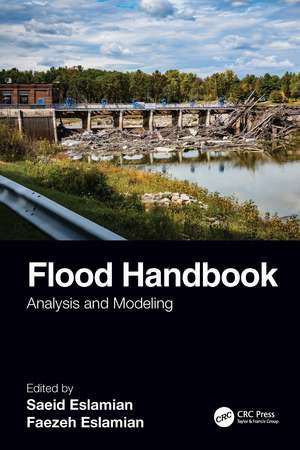Flood Handbook: Analysis and Modeling
Editat de Saeid Eslamian, Faezeh Eslamianen Limba Engleză Paperback – 26 aug 2024
Features:
- Presents the main principles and applications of the science of floods, including engineering and technology, natural science, and sociological implications.
- Considers floods in urban, agricultural, rangeland, forest, coastal, and desert areas.
- Covers flood control structures as well as preparedness and response methods.
- Written in a global context, by contributors from around the world.
| Toate formatele și edițiile | Preț | Express |
|---|---|---|
| Paperback (1) | 470.32 lei 6-8 săpt. | |
| CRC Press – 26 aug 2024 | 470.32 lei 6-8 săpt. | |
| Hardback (1) | 1294.19 lei 6-8 săpt. | |
| CRC Press – 11 apr 2022 | 1294.19 lei 6-8 săpt. |
Preț: 470.32 lei
Preț vechi: 553.32 lei
-15% Nou
Puncte Express: 705
Preț estimativ în valută:
90.01€ • 93.26$ • 75.12£
90.01€ • 93.26$ • 75.12£
Carte tipărită la comandă
Livrare economică 21 martie-04 aprilie
Preluare comenzi: 021 569.72.76
Specificații
ISBN-13: 9781032201870
ISBN-10: 1032201878
Pagini: 640
Ilustrații: 518
Dimensiuni: 178 x 254 mm
Greutate: 1.18 kg
Ediția:1
Editura: CRC Press
Colecția CRC Press
Locul publicării:Boca Raton, United States
ISBN-10: 1032201878
Pagini: 640
Ilustrații: 518
Dimensiuni: 178 x 254 mm
Greutate: 1.18 kg
Ediția:1
Editura: CRC Press
Colecția CRC Press
Locul publicării:Boca Raton, United States
Public țintă
AcademicCuprins
Part I: An Introduction to Flooding and Human
- Floods and People-Colin GreenPart II: Food Observation and Modeling Uncertainty
- Importance of Hydrological and Meteorological Measurements and Observation
- Flood Observation Uncertainty-Jean-François Vuillaume
- Flood Modeling and Forecasting Uncertainty-Jean-François VuillaumePart III: Flood Modeling and Forecasting
- Empirical Modelling in Design Flood Estimation-Akshay Rajan Thorvat
- Flood Forecasting Time Series or Flood Frequency Analysis-Priyanka Sharma
- Stable Channel Design of Tapi River Using Hec-Ras For Surat Region-Darshan J. Mehta
- Hydro-Morpho Dynamics of River Junctions Characteristics and Advanced Modeling-Hydar Lafta Ali
- Shallow Water Flow Modelling-Franziska Tügel
Part IV: Flood, River Restoration and Climate Change - Modelling Approach in Forecasting Changes Caused By In-Stream River Restoration Structures-Tomasz Kaluzal
- Impact of Climate Change on Flooding-Conrad Wasko
- Sea Level Rise Due to Climate Change- Brij BhushanPart V: Flood Optimization and Simulation
- Real-time Operation of Reservoirs during Flood Conditions using Optimization/Simulation-Larry Mays
- Application of Physically-Based Distributed Flood Models Towards Large-Scale Flood Simulations-S. Saksena
- Continuous Large-scale Simulation Models in Flood Studies-Rouzbeh NazariPart VI: Flood Softwares
- Riverine and Flood Modeling Softwares-Mustafa Goodarzi
- Flood Modelling Using Open Source Software-Thomas J Scanlon
- Iterative Floodway Modelling Using HEC-RAS and GIS- Majid Galoie
- Flood Plain Mapping using HRC-RAS and ArcGIS-Mehdi Vafakhah
- Geospatial Techniques, Flood Hazard, Vulnerability and Risk Mapping in GIS GAP-Ali Akbar JamaliPart VII: Flood Regionalization
- Determining the High Flood Risk Regions Using a Rainfall-Runoff Modeling- Iftekhar Ahmed
- Geostatistics and Flooding-Homogeneous Regions Delineation for Multivariate Regional FA-E. Gargouri
- Application of L moments Based Index Flood Approach: A Case Study for NSW, Ayesha Rahman
- NASA Near-Real-Time Global Precipitation Products for Flood Modeling, Assessment, and Research- Zhong LiuPart VIII: Flood Softcomputing
- Real time Flood Hydrograph Predictions using Soft Computing and Rating Curve Methods- Gokmen Tayfur
- Application of Integral Transforms in Hydrology-Vahid Nourani
- Multi-Criteria Decision Analysis For Flood Risk Assessment-Daniel Jato-Espino
Notă biografică
Dr. Saeid Eslamian is professor of Hydrology at Isfahan University of Technology, where he heads the Hydrology Research Group in the Department of Water Engineering. His research focuses mainly on statistical and environmental hydrology and climate change. In particular, he is working on modeling and prediction of natural hazards including flood, drought, storms, wind, groundwater drawdown, and pollution for arid and semi-arid zones, particularly in urban areas. He is also a Visiting Professor at Princeton University, and University of ETH Zurich, Switzerland.
He has contributed to more than 300 publications in books, research journals, and technical reports or papers in conferences. He is the Founder and Editor-in-Chief of both the International Journal of Hydrology Science and Technology and the Journal of Flood Engineering. He received ASCE and EWRI awards in 2009 and 2010 for his research.
Faezeh Eslamian is a PhD candidate of bioresource engineering and research assistant at McGill University, Montreal, Quebec, Canada. She is currently working on the fate and transport of phosphorus through subsurface drained farmlands. Dr. Eslamian completed her bachelor’s and master’s degrees in civil and environmental engineering from Isfahan University of Technology, Iran, where she evaluated natural and low-cost absorbents for the removal of pollutants such as textile dyes and heavy metals. Furthermore, she has conducted research on the worldwide water quality standards, wastewater reuse, and drought guidelines.
He has contributed to more than 300 publications in books, research journals, and technical reports or papers in conferences. He is the Founder and Editor-in-Chief of both the International Journal of Hydrology Science and Technology and the Journal of Flood Engineering. He received ASCE and EWRI awards in 2009 and 2010 for his research.
Faezeh Eslamian is a PhD candidate of bioresource engineering and research assistant at McGill University, Montreal, Quebec, Canada. She is currently working on the fate and transport of phosphorus through subsurface drained farmlands. Dr. Eslamian completed her bachelor’s and master’s degrees in civil and environmental engineering from Isfahan University of Technology, Iran, where she evaluated natural and low-cost absorbents for the removal of pollutants such as textile dyes and heavy metals. Furthermore, she has conducted research on the worldwide water quality standards, wastewater reuse, and drought guidelines.
Descriere
Written by experts from around the world, this handbook presents different aspects of flooding in the context of changing climate and across geographical locations.
